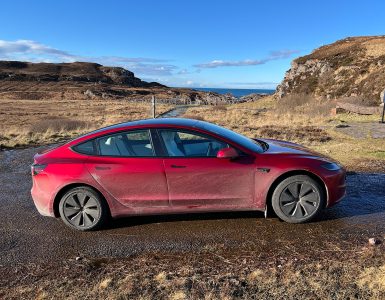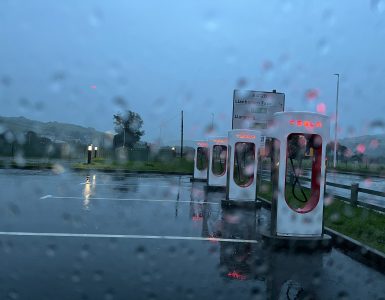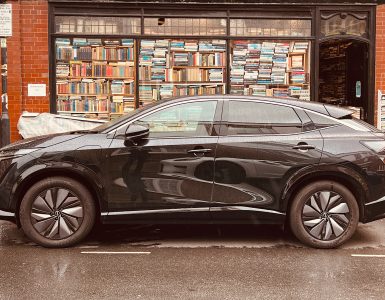Updated. On the 8th October 2021 I did a trip from Putney in SW London to the Scottish Event Campus in Glasgow which is the venue for the COP26 summit. I then continued onto Crianlarich in the Highlands.
By complete coincidence the same day the Campaign for Better Transport arranged a race from London to Glasgow with one person going by air and one by train from city centre to city centre. Their journey was designed show how rail journeys should replace all domestic flights where a train can take about the same time or less. A big factor in this is the ticket costs which favour subsidised air travel despite it being far far worse for CO2 emissions. Something is very wrong with UK policy if high carbon flying is much cheaper than a train.
Vehicle – Electric Tesla Model 3 Dual Motor Performance minus
- From Putney with 294 miles range
Departure 0744am - 168.9 miles Charge stop 1 Keele Service M6 Northbound
10.41am Arr 72 Miles range
11.04am Dep 229 miles range +157miles in 25 mins - 331.7 miles Charge stop 2 Gretna Services, Scotland
13.42 Arr 40 miles range
13.55 Dep 91 miles range +51 miles in 13 mins
Something very unusual happened at Gretna.. a Tesla Supercharger queue. In fact there were big queues for all the food outlets inside too so there was a 25 minute wait before the charge began.Its possible to avoid Gretna (which only has 4 stalls that deliver power quite slowly when all are in use at once). As a result I just added enough range to reach Abington - 379.5 miles Charge stop 3 Abington Services Scotland
14.38 Arr 26 miles range. Used 109 kWh so far
15.29 Dep 236 miles +210 miles in 51 mins
Lunch stop and needed enough range to reach Fort William supercharger 517 miles from London as a safety net in case of charger issues at Crianlarich.
Only a 10 minute charge would have been required to reach Scottish Event campus but it was also a meal stop anyway. - 413 Miles Scottish Event Campus (Cop26 Venue) SEC Hydro Car park
16.29 Arrived
17.20 Departure - 476.0 miles Crianlarich Best Western Hotel with 134 miles range
19.39 Arrival. Used 135kWh / efficiency 284Wh/mile or 3.52 miles per kWh
Dep 0916am Left with an overnight charge of approx 270 miles +136
Trip Summary & Carbon intensity London to Glasgow
- Total required charge time to COP26 48 minutes
- 413 mile trip used an estimated 117.1 kWh
- UK 2020 Electricity Carbon intensity was only 181g of CO₂ per kilowatt hour. This would make the carbon intensity of the trip 21.19kg. Based on the 2019 figure of 233g of CO₂ per kilowatt hour the one way trip COe was 27.28 kg of CO2
- 2023 Update – the UK carbon intensity in the 12 months to May 2023 has now fallen below the 2020 lockdown figure to 176g/kWh. This should take the train under 20kg and the electric car is now down to 20.6kg and likely to fall below 20kg during this year. Offshore wind was the biggest source of UK electricity in Q1 2023.
- Beyond – Actual trip continued to Crianlarich 476 miles was 31.45kg of CO2 based on the 2019 numbers or 24.4 kg based on the lower 2020 UK carbon intensity figure
- After spending time in the Highlands the trip was reset for the return leg at “the Kelpies” the dramatic horse head sculptures between Stirling and Edinburgh at Grangemouth. Final journey taking the east coast route was longer 446.4 miles but more efficient 266 Wh/mile using 119kWh on the trip.
Comparison with other Transport from London to Glasgow
| Transport type | Journey time inc stops | Cost | CO2 London Glasgow (kg) |
|---|---|---|---|
| Plane 5 hrs 17mins/ | 5 hrs 17mins | £52 | 137 kg worst |
| *Diesel car 40mpg | 8 hrs 5 mins | £68.01 | 125.7 kg |
| *Petrol car | 8 hrs 5 minutes | £65.67 | 108.36 kg |
| *Electric car | 8hrs 34 mins | £41.44 cheapest | 21.19-27.28 kg |
| Electric train | 5hrs 19 mins | £109 most expensive | 20 kg lowest |
- *Electric car sole occupant / £17.64 departure charge+£23.88 = £41.44 / Total charge cost £51.44 with charge to reach Fort William in the Highlands
In addition to charge time there was a 15 minute wait to use the charger at Gretna Green - Petrol 40mpg car sole occupant 10.32 gallons. x 4.546 =46.91 litres
2.31 kg of CO2 is produced per litre of petrol burnt producing a trip CO2 of 108.36 kg
A petrol car with one occupant doing 31.6 miles per gallon will produce the same CO2 as the plane. Any lower and it will produce even more CO2 than flying
Petrol price calculated at £1.40 a litre - Diesel 40mpg car sole occupant 10.32 gallons. x 4.546 =46.91 litres
2.68 kg of CO2 is produced per litre of diesel burnt producing a trip CO2 of 125.7 kg - a diesel doing 40 mpg car with 4 people on board will still produce more CO2 per person than the electric car with only the driver in the car.
Diesel price calculated at £1.45 a litre - A diesel car with one occupant doing 36.7 miles per gallon will produce the same CO2 as the plane. Any lower and it will produce even more CO2 than flying
- Even a 50 mpg diesel car produces 100 kg of CO2. 5x the train and 4x the electric car.
- For petrol / diesel cars we still assumed a 30 min1 meal stop and 2 15 min coffee and toilet stops
- For EV we deducted charge time over an above 30 mins meal stop as it would not have been required to reach Glasgow






SSE Hydro is the round building
The Armadillo is the one that looks like the Sydney Opera House
and the small looking building between is the SEC centre, easily the biggest of the 3
Tops tip if going to COP26 with an EV?
- Arrive with plenty of charge and ideally find AC Chargeplace Scotland chargers to slow charge for the return leg.
- There will be 240 Jaguar iPace EV’s ferrying dignitaries around & all will need to charge probably daily
- Nearly all Scottish DC chargers are 50kW units that will likely be busy charging visiting EV’s and the iPace fleet very slowly indeed.
- There are Tesla Superchargers just East of Glasgow on the M8 and South of Glasgow at Abington
- Try and get hold of a Chargeplace Scotland RFID card as the app is flaky. The app works slightly better on the slow AC chargers than on the DC units. Main issues found were charger ID’s that were wrong including in the COP26 venue car park (so you can’t easily find which charger to start a charge) and the app thinking a charger was busy when it wasn’t (so you can’t start a charge at all!)
- If you get stuck check Zap Map for other options including some Osprey chargers (still only 50kW)
- on the way up to Scotland EpicwinningMaz on twitter has done a great map to help you find the new upgraded Gridserve motorway service station chargers and avoid the remaining old unreliable ecotricity units
- BP have the only public chargers quicker than 50kW near Glasgow at Harthill North and South Service areas with 10 150kW units (5 in each direction at the services.
Update! Ionity have just opened a 6 stall 350kW charger at on the outskirts of Glasgow at Polmadie (junction 1a on the M74). Bear in mind both of these rapids could be being prioritised for official COP26 fleet vehicles during the conference.






